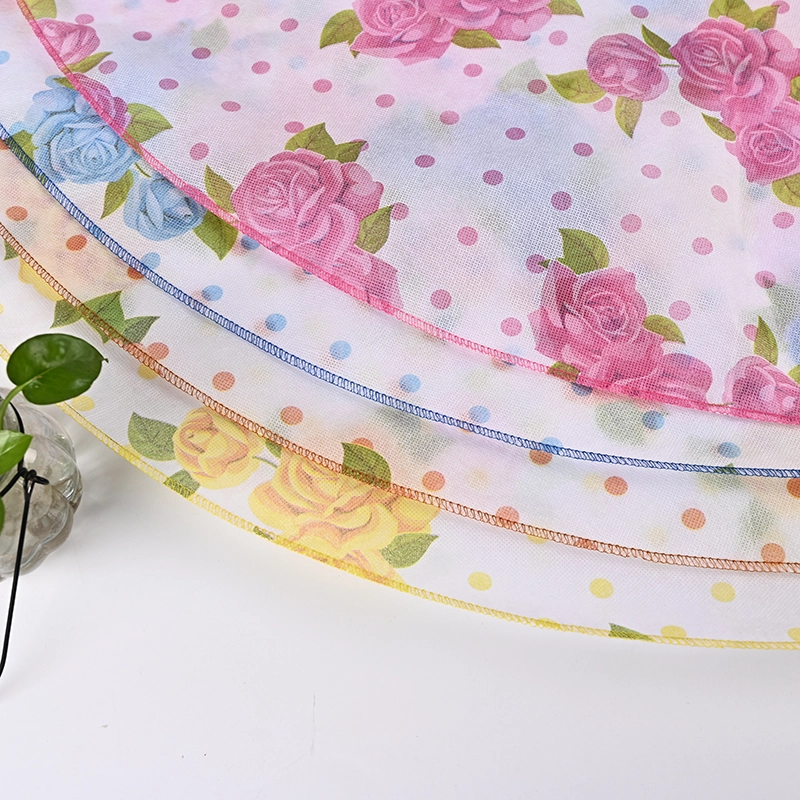Nonwoven fabrics differ from woven or knitted fabrics in terms of properties and manufacturing methods.
Here are some key differences:
Structure: Woven fabrics are made by interlacing two sets of yarns, known as warp and weft, at right angles to each other. Knitted fabrics are created by interlocking loops of yarn. Nonwoven fabrics, on the other hand, are manufactured by bonding or interlocking fibers together without using a weaving or knitting process. The fibers in nonwoven fabrics can be mechanically, chemically, or thermally bonded.
Properties: Woven fabrics are typically characterized by their strength, stability, and dimensional stability. They have well-defined grain lines and exhibit good tensile strength in both directions. Knitted fabrics offer stretch and flexibility due to their looped structure. Nonwoven fabrics, depending on the manufacturing process and fibers used, can have a range of properties such as absorbency, filtration efficiency, softness, insulation, or barrier properties.
Manufacturing: Woven fabrics are produced on looms, where the warp and weft yarns are interlaced using various weaving techniques. Knitted fabrics are manufactured on knitting machines that form loops of yarns. Both woven and knitted fabrics involve a continuous process with yarns as the starting material. Nonwoven fabrics, on the other hand, are created directly from fibers. nonwoven fabric supplier The fibers can be carded, spun, or laid in a random or oriented arrangement, and then bonded together using mechanical, chemical, or thermal methods.
Cost and Efficiency: Woven and knitted fabrics require a series of manufacturing steps, including yarn production, warping, weaving or knitting, and finishing processes. These processes can be time-consuming and labor-intensive, which can increase the cost of production. Nonwoven fabrics, on the other hand, can be manufactured more efficiently and cost-effectively. The absence of weaving or knitting processes reduces production time and eliminates the need for additional steps such as warping or finishing.
Design Flexibility: Woven and knitted fabrics offer greater design flexibility in terms of pattern, texture, and drape. Different weaving patterns or knitting stitches can be used to create various fabric structures and visual effects. Nonwoven fabrics, while they may not offer the same level of design flexibility, can be engineered to have specific properties and functionalities through the choice of fibers, bonding methods, and manufacturing parameters.
Recycling and Sustainability: Woven and knitted fabrics can be recycled through processes like shredding, melting, or chemical dissolution. Nonwoven fabrics, depending on the bonding method and fiber composition, can also be recycled. However, the recycling processes for nonwoven fabrics may be more complex due to the various bonding techniques used.
These differences in structure, properties, manufacturing methods, and cost make each fabric type suitable for different applications. Woven fabrics are commonly used in apparel, home textiles, and industrial applications. Knitted fabrics are often found in garments, sportswear, and medical textiles. Nonwoven fabrics are widely used in hygiene products, medical supplies, geotextiles, filtration, packaging, and various other applications where their specific properties and cost-effectiveness are advantageous.
Can you provide more examples of applications where nonwoven fabrics are advantageous?
Here are some additional examples of applications where nonwoven fabrics offer advantages:
Agriculture: Nonwoven fabrics are used in agriculture for crop protection, weed control, and soil stabilization. They can be employed as agricultural covers to shield crops from adverse weather conditions, insects, and pests. Nonwovens also serve as mulch fabrics, helping to retain moisture, control weed growth, and regulate soil temperature.
Furniture and Bedding: Nonwoven fabrics find application in the furniture and bedding industry. They are used as upholstery materials, mattress components, and fillings. Nonwovens provide cushioning, comfort, and durability while allowing for breathability and moisture management.
Insulation: Nonwoven fabrics are utilized in the insulation industry for thermal and acoustic insulation products. They can be found in building insulation, automotive insulation, and industrial insulation applications. Nonwovens offer excellent thermal resistance, sound absorption, and lightweight properties.
Cleaning and Wiping: Nonwoven fabrics are widely used in cleaning wipes, disposable towels, and industrial wipes. They provide absorbency, strength, and lint-free cleaning performance. Nonwoven wipes are convenient, hygienic, and suitable for various cleaning tasks in household, healthcare, and industrial settings.
Shoe and Leather Goods: Nonwoven fabrics are utilized in footwear manufacturing for insoles, linings, and reinforcements. They offer cushioning, moisture management, and breathability. Nonwovens can also be found in leather goods such as bags, wallets, and belts as lining materials or structural components.
Protective Apparel: Nonwoven fabrics are used in the production of protective apparel, including coveralls, gowns, masks, and shoe covers. They provide barrier properties against hazardous substances, particulates, and fluids. Nonwovens offer comfort, breathability, and protection in industries such as healthcare, pharmaceuticals, cleanrooms, and chemical handling.
Sound and Vibration Dampening: Nonwoven fabrics find application in the automotive and industrial sectors for sound and vibration dampening. They can be used as acoustic barriers, interior trim components, and under-carpet insulation. Nonwovens help reduce noise transmission and improve overall acoustic comfort.
Filtration Media: Nonwoven fabrics serve as filtration media in various applications. They are used in air filters, liquid filters, HVAC systems, face masks, and respirators. Nonwovens offer high filtration efficiency, low airflow resistance, and the ability to capture particles of different sizes.
Industrial Wiping and Polishing: Nonwoven fabrics are employed in industrial settings for wiping, polishing, and surface preparation. They are used in electronics manufacturing, automotive detailing, printing, and other industries requiring clean and lint-free surfaces.
Battery Separators: Nonwoven fabrics are used as separators in batteries, particularly in lithium-ion batteries. They provide electrical insulation between the battery’s anode and cathode, preventing short circuits while allowing for the flow of ions.
These are just a few examples of the diverse applications where nonwoven fabrics offer advantages. The versatility, specific properties, and cost-effectiveness of nonwovens make them suitable for a wide range of industries and products.
